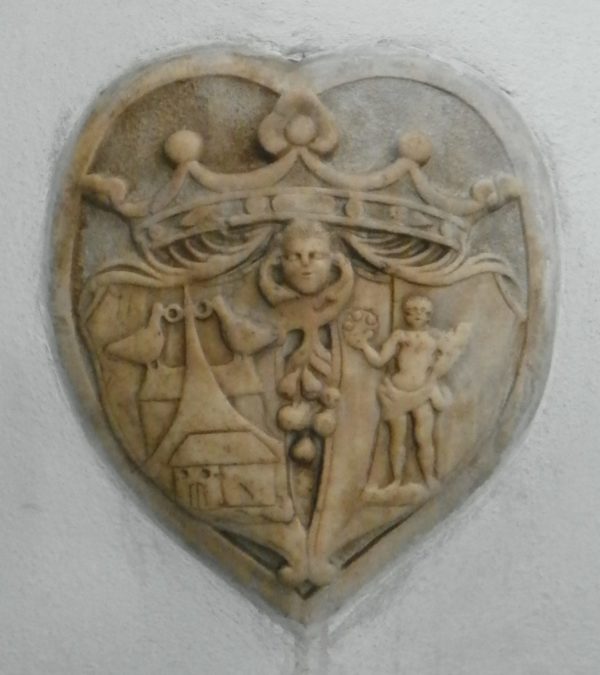
Arms of alliance of the Schellenburg and Hofstätter families in Ljubljana
LJUBLJANA, URSULINE CHURCH OF THE HOLY TRINITY
Location of the coat of arms: other
Only rare individuals had such profound influence on the development of Ljubljana and the wider province of Carniola as the wholesaler, financier, and patron of the arts Jakob Schell von Schellenburg at the turn of the eighteenth century. Although he engaged in trade and finances, unlike his peers, he also had a keen sense of art and culture. He was born in 1652 in the southern Tyrolian town of Sterzing (modern Vipiteno) to the saddle master Jakob Schell and Justina Atzwanger. He had three sisters and a brother, Thomas, who became a priest and was raised to nobility together with him in 1696.
Jakob first appeared in written sources—already as a merchant—at the end of the 1670s in Vienna and then in the Friulian town of Udine. In 1684, sources also mentioned him in Ljubljana, concluding the first trade contracts for local Carniolan products. Recognizing the immense potential of easily accessible Carniola and especially Ljubljana for trade between Trieste and its hinterlands, he decided to settle there permanently. At the end of 1684, he rented a warehouse on Breg. On October 23rd the following year, he married a Ljubljana-native, Ana Katarina Hofstätter (1662–1732), thus meeting one of the conditions for obtaining the status of a townsman.
Immense wealth that he had accrued from trade also enabled him to engage in other financial transactions. To the Carniolan provincial estates, plagued by constant financial difficulties, he lent enormous sums of money and became their principal creditor. In addition to money lending, his financial business comprised running financial and economic affairs for high noblemen in Carniola and Carinthia. Finally, he also gave a generous loan to the ever-empty imperial treasury in the “dark and dire times of war.” For this reason (and other outstanding services for the imperial court and the town of Ljubljana as well as the merit of his Tyrolian ancestors), in 1696 Emperor Leopold I granted him the title of nobility with the predicate Schellenburg and appointed him as the imperial councilor. On that same occasion, nobility was also granted to his brother Thomas, the priest. Rather than conferring a new coat of arms on the ennobled brothers, the emperor merely confirmed the old one, which was granted to the family by his father, Ferdinand III. It depicted a forest man holding an uprooted tree in one hand and a ring with sleigh bells in the other; the sleigh bells were a pun on Schell’s name (bell = Germ. die Schelle).
Schellenburg above all supported religious institutions and donated generously for the decorations of Carniolan churches. His greatest merit was to bring the Order of Saint Ursula to Ljubljana in 1702. In addition to providing the financial means necessary for the construction of the monastery, he also purchased the neighboring gardens from the Princes Auersperg and Eggenberg to ensure the development of a vast monastery complex. Because one of the conditions for the Ursulines to move from Gorizia (Germ. Görz) to Ljubljana was their vow to engage in educational activity, it was precisely Schellenburg, who also enabled the establishment of the first school for girls in Ljubljana. The school remained the only educational institution for girls in the town for another 170 years.
Schellenburg did not live to see the completion of the monastery. He died on the night from February 1st to February 2nd, 1715, and was buried in the Ursuline monastery church. His coat of arms, combined with that of his wife Ana Katarina Hofstätter (who appears not to have been of noble descent), still serves as a reminder of that. After their marriage did not produce any children, he bequeathed his estate to churches in Ljubljana and throughout Carniola and donated for charitable purposes. His estate funded numerous “scholarships” (Germ. Stiftung) that remained in use until the end of the monarchy.
In 1877, the former Nunska (Nuns’) Street running past the Ursuline monastery in Ljubljana was named after Schellenburg. In 1952, Schellenburgova (also Šelenburgova) Street was renamed after Edvard Kardelj and in 1954, it became part of Tito Road; today, it forms part of Slovenian Road. The memory of Schellenberg is now honored by giving his name to the new residential complex on Gosposvetska Road occupying on the site of the former Coliseum.
Sources:
Preinfalk, Miha: Plemiške rodbine na Slovenskem. 17. stoletje. 1. del – Od Billichgrätzov do Zanettijev. Ljubljana, 2014, pp. 131–135.
